Latest reviews
Was ist denn hier passiert? Brauchten die Beteiligten etwa finanzielle Mitte und haben sich vom Aufguss der Reihe einen Geldsegen versprochen? Der Anfang des Films hat mich schon sehr verwirrt. Die Szenen springen wild in der Welt umher und werden dann nur mit Mühe zu einer Story versponnen.
Die Actionanteile des Films sind solide, die Story eher nicht. Und ich kann nicht einmal das Ende des Films Spoilern, denn dieses habe ich nicht mehr geschaut. Finger weg von diesem Film. Ein solches Ende (hoffentlich) hat diese Reihe nicht verdient.
看了某篇文章推荐所以就试了试,还行吧!每次打开都有那种名言警句,挺不错;记录自己的想法能够让自己的宠物鸡获得能量,有了足够的能量它就会外出探险,探险过程中记录会让它快点回来;回来以后它会分享它的发现,就是那种我们都很熟悉的东西它都有它自己的理解,就超可爱,这个时候你就要告诉它这东西本质是怎么回事之类的,挺好玩的。
搜索量表的时候发现的,最开始发现的还是它的中文机翻版(不得不说,好多网站都在机器翻译英语的文章,弄得一塌糊涂,真是互联网上的糟粕啊)。每一篇文章都是有撰稿人的,写作偏科普,里面的知识可能不一定精确,简单了解还好,如果是想好好学习则需要对照更多材料。
If you’ve ever played one of the classic Sierra point and click adventure games (e.g., Space Quest) and thought “Gee, the one thing this game really needs to be more fun is more random ways to die!”, then House may be your personal game of the year.
You’re a young girl in the eponymous house which is, of course, haunted. Every day you awaken in a home that is newly trying to kill you and your family. Will you save everyone, or will you be the one who does the killing?
The game uses very simple but expressive pixel art, with special attention to death and gore animations. You walk from room to room, pick up items and weapons, and pursue one of the multiple endings. If you die (which you will, many times), you wake up again.
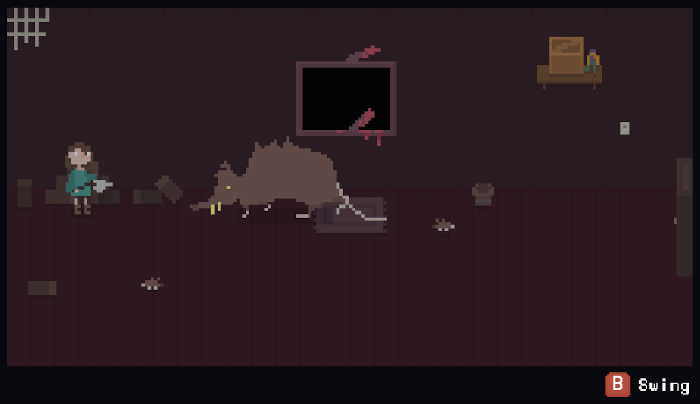
The rodent of unusual size in the basement is the least of your problems. (Credit: Bark Bark Games. Fair use.)
This is an action-adventure—timing and precision do matter. Each run only takes a few minutes, and some aspects of the environment change subtly over time. To survive, you have to make mental (or written) note of what you’ve tried, and where you’ve died.
The game has received many positive reviews on Steam (fluctuating between “Very Positive” and “Overwhelmingly Positive”). I spent about an hour with it before getting frustrated by the repetition and heading to YouTube to watch the endings. Don’t let my experience dissuade you, though. There is a lot to discover in this $5 game, including interesting details about each character—if you don’t mind dying many times in a short loop.
After you die, if your spirit is out of balance, you spend time in limbo as a ghost with too much energy, or as a reaper with too little. Reapers collect the excess energy of ghosts, helping them to pass on—until they have collected enough energy to pass on themselves.
And so is is that a young girl named Lavender finds herself waking up in Grimm’s Hollow as a reaper tasked by the grim reaper (AKA Grimm) with collecting ghosts. Lavender is understandably skeptical of this assignment, but plays along in hopes that she may find her brother Timmy.
Grimm’s Hollow is a freeware indie game by developer ghosthunter, made with the popular RPG Maker software. Much of the game consists of exploring three caves, in which you encounter fellow reapers and fight ghosts in turn-based battles with quick-time events.
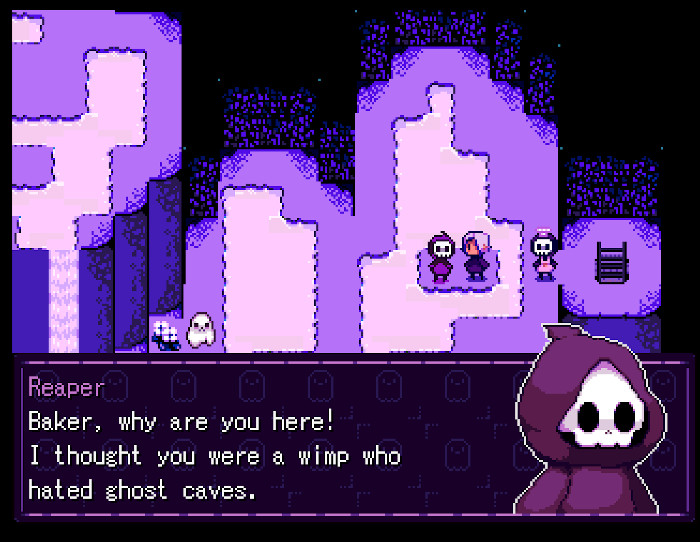
The battle-shy baker is tasked by Grimm to accompany Lavender as part of her training as a reaper. (Credit: ghosthunter. Fair use.)
The combat system can be a bit frustrating at first, but once you master it, you’re unlikely to have any issues until the final battle. What makes Grimm’s Hollow a gem of a game is the attention to the story, the worldbuilding, and the characters.
For example, to heal, you collect treats such as “Spooky Cookies” and “Deathlicious Donuts”, all rendered in beautiful pixel art. The baker has made a special deal with Death that he can avoid ghost battles if he just keeps the goods coming.
Grimm’s Hollow features four different endings. If you lose the final battle, make sure to retry until you get at least one of the good endings. The game also offers save slots, but you’re unlikely to need them once you’ve mastered the initial learning curve. All in all, it’s a 3-4 hour experience, and a wonderful treat that should not be missed.
Although this is a Windows game, I played it on Linux using Steam/Proton with only one minor issue: the top GNOME menu bar stayed visible in full-screen mode (without overlapping with the game’s contents).
If you love the game and want to express your appreciation for the developer, you can purchase an art pack on Steam or itch.io.
Sometimes I pick up indie games that look just weird enough to be interesting. Alien Function is definitely such a game. It is part of a series featuring the same cast of characters, but it works as a standalone story.
You play a guy named Typhil, who works as an agricultural technician on a starship that seems to have no aim or purpose other than to maximize its production of rutabagas.
The first half of the game could be described as a “daily grind simulator”, in which you are assigned various technical tasks related to rutabaga production: optimize fertilizer output, manage pest control, and so on. You do this by piecing together clues on a virtual desktop that looks kind of like Windows 95.
Through limited interactions with your colleagues on the starship (who are dressed like they escaped from a fantasy RPG) you become aware of a series of crew member disappearances. Eventually, a colleague teaches you hacking skills, and you start to snoop around in the ship’s private data stores…
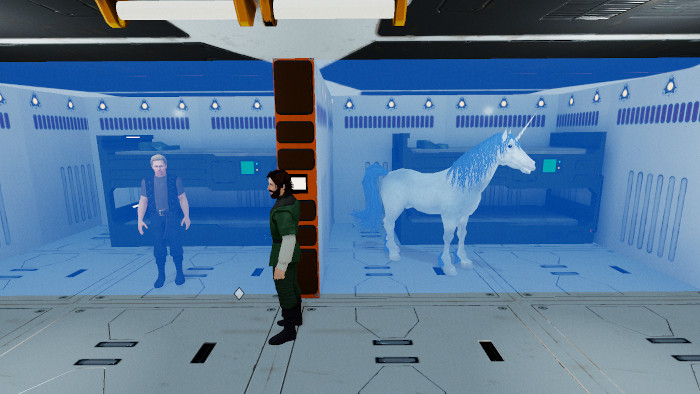
You have to have a certain amount of respect for a game that puts a unicorn in the holding cell of a starship. (Credit: Stand Off Software. Fair use.)
The gameplay is a combination of 3D point-and-click with puzzle elements. There is no hint system, and there is only autosave, but I never got into a dead end where I could no longer progress. I finished the game without a walkthrough in about 4 hours—indeed, its’s so obscure that no walkthrough appears to exist as of this writing.
Astonishingly, Alien Function is fully voice-acted. While nobody is going to win any awards for it, I never found it grating (well, almost never—one character sounds constantly annoyed, but I think she is supposed to).
The story doesn’t hold any dramatic surprises, and the mid-2000s quality 3D graphics (pieced together from various assets), combined with some drawn out puzzles, make it difficult to truly recommend the game. As an indie passion project that delivers 4-5 hours of surreal playtime, it’s still an achievement. If you do pick it up, make sure to start with the tutorial, which is both funny and important to understand the game’s controls.
Kelvin and the Infamous Machine (2016) is an indie point-and-click adventure in the tradition of games like Day of the Tentacle (1993) and films like Bill & Ted’s Excellent Adventure (1989). It was developed by Blyts, a small Argentinian studio that managed to raise just under $30K in a Kickstarter to fund its work.
The game follows a classic premise: 1) scientist invents time machine; 2) scientific community ridicules scientist; 3) mad scientist goes back in time to claim credit for the world’s greatest scientific and creative achievements. Kelvin and Lise, the mad scientist’s research assistants, try to stop him and to set things right(-ish).

The game’s cartoon graphics are not overly detailed but still appealing. A rich cast of characters keeps things interesting. (Credit: Blyts. Fair use.)
A Tales As Old As Time
You exclusively play as Kelvin, a clueless goofball willing to try almost anything. That makes him a great protagonist for a point-and-click adventure where much of the gameplay consists of picking up every random item you see in hopes that it will be useful to solve some puzzle later on.
Our adversary, Professor Lupin, has messed with Ludwig van Beethoven, Leonardo da Vinci, and Isaac Newton—preventing them from completing their work, while claiming all credit for himself. Kelvin, guided remotely by Lise, visits their respective time periods to restore some semblance of sanity.
The world is filled with wacky characters—a tea merchant selling a disgusting brew made with a contraption of military origin; an utterly incompetent incarnation of Robin Hood; a gravedigger enamored with pictures of cute animals.
Short but Well-Rounded
This is a comedy game that relies heavily on pop culture references, from Harry Potter to Doctor Who. It’s not quite as consistently funny as comedy adventure hits like The Darkside Detective, but it definitely has its moments.
You’re likely to finish Kelvin in 4-5 hours. The mostly inventory-based puzzles can get a bit tedious, but thanks to good game design, you’re unlikely to get stuck anywhere for very long. The game is fully and competently voice-acted; the overall sound design could have used some polish (music does not always play when you may expect it to). The user interface is as simple as it gets, with one-click interactions and fully automatic saves.
3.5 stars, rounded up for the little details that show that it’s a work of passion—such as optional, unlockable scenes that reward extra exploration. Especially recommended for younger audiences.
There’s a good chance that you own multiple devices that give you access to an almost limitless library of games. But there was a time when video game arcades were the place to go to exchange coin after coin for minutes or hours of entertainment—alone or in the company of your friends.
That’s the past that 198x evokes, promising “a coming-of-age story told through multiple games and genres”. Our protagonist, “Kid”, is an alienated suburban teen who discovers a local video game arcade as a means of escape.
The story is minimalist and mostly told through large, beautiful pixel art scenes. Kid is also the game’s narrator. Their melodramatic monologue is at odds with Kid’s privileged and not particularly eventful adolescence. The story ends on a flat note, promising a sequel which may or may not come.
At the core of 198x are five video game vignettes: a beat ‘em up, a space shooter, a racing game, a hack-and-slash platformer, and a dungeon crawler.
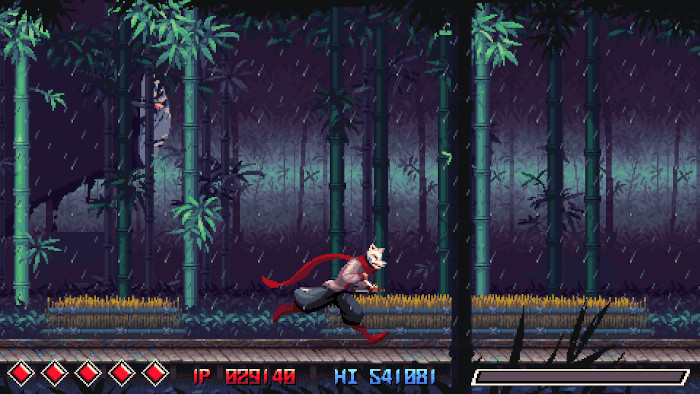
Shadowplay is the most well-rounded of the minigames, with wonderful art and a genuinely creepy boss that chases you in the final stage. (Credit: Hi-Bit Studios. Fair use.)
These are not fully fleshed out games, and they fade out after a few stages. They do successfully evoke the 16-bit gaming era, with Out of the Void (the space shooter) and Shadowplay (the platformer) feeling the most developed.
Most players will be done with 198x after 1-2 hours. Depending on your tolerance for teenage angst, you may find the storytelling portion more annoying than atmospheric; either way, the pixel art is undeniably gorgeous throughout the game.
I would give the game overall 3.5 stars, rounded down because of the underwhelming story. If you like retro games and pixel art, I would recommend checking it out at a discounted price or in a bundle.
Metroid: Other M is the 2010 main entry into the long-running Metroid series that hadn’t seen a major release for almost a decade at that point with Metroid Fusion. The series at large had already seen a return to home consoles with the Metroid Prime spin-offs, but this game brought the main series back to them as well. With this return Team Ninja and Nintendo attempted to give this series a new coating: getting the main series to 3D, shifting the gameplay focus to combat, and extending the Metroid universe with a huge story.
Similarities/Differences
There is a lot of overlap with previous Metroid games in Other M, despite these huge ambitions.
Structurally the game borrows heavily from Metroid Fusion, taking place in a huge spaceship with one main sector that branches off into several others, each with a different theme. And also the story takes quite a bit out of Fusion’s book: it focuses on the Galactic Federation and its secret bioweapons research—just much bigger in scope this time.
The transition to 3D had already happened successfully for the series with the aforementioned Metroid Prime by Retro Studios. And certainly, a lot of lessons learned about how to transform the exploration of environments from 2D to 3D were applied here. But unlike Metroid Prime, Other M uses the third-person perspective, instead of first-person.
Story
The main difference between this game and the rest of the series is the storytelling. Up until this point the series had mostly relied on telling its story through the environment and events that are experienced directly in the gameplay space. This basic approach had already been extended by Fusion with a periodically delivered monologue, either directed at the protagonist, Samus Aran, or monologue of her own—directed inwards. Other M keeps all of this and erects a framework of a grand, traditionally told story around the entire game. Samus receives a backstory, explicit characterisation, and a cast of characters to interact with. On top of that, the game is fully voice acted. And all of this is supported by pre-rendered cutscenes by the animation studio D-Rocktes, which look spectacular, especially by Wii standards.
The game is set directly after the events of Super Metroid. Samus returns from her mission in that game, in which she successfully obliterated the planet of the Space Pirates. The baby Metroid that she set out to rescue on the mission, however, sacrificed itself in the final battle to rescue her.
Other M sets off when Samus receives a distress call which leads her to a seemingly abandoned and gigantic spaceship. And there she coincidentally bumps into a Galactic Federation squad under the leadership of her former military superior Adam Malkovich. She joins the group under Malkovich’s command and they begin investigating the place together. Soon it becomes clear that the ship houses the Galactic Federation’s secret bioweapons research project and that the place might house some other secrets too.
The story builds up Samus’ character and paints a pretty harrowing picture. The loss of the baby Metroid that saw her like a mother has affected her greatly and now, meeting people from her old life in the Galactic Federation army, opens up many wounds from the past. The game communicates her bad mental state by giving her a cold, detached and monotone voice, especially for internal monologues.
Throughout the game, you dive deeper into her damage with previous missions of hers and specifically her relationship to Adam, whom she sees as a father. This is also why she joins the group so readily under Adam’s command: she wants to make amends for the mistakes that lead to her leaving the military. She wants to prove her loyalty to him.
Broadly, the game has a theme of loss of control. Not only does Samus, who generally works alone, surrender authority to Adam, but further, many important plot points in the story do not get resolved by her. She isn’t the one in control, even though she is the protagonist of the game.
Moreover, by casting the Galactic Federation in the role of the villain, Samus doesn’t have much room to play the hero. After all, those are the people on whose behalf she just carried out her last mission.
The good-evil reversal with the Galactic Federation doesn’t sound all that interesting on the surface—that’s what Fusion already did—but combining it with Samus’ involvement and turning it into a story of overcoming trauma is a lot more compelling already. It goes further though: not only does nothing fundamentally change about the evil parts of the Galactic Federation, its bioweapons experiments continue in Metroid Fusion, which chronologically follows Other M. Adam Malkovich is portrayed as the only counterweight, as he explicitly opposed the bioweapons research but failed in preventing it from happening.
It’s a display of cynicism about the ability of large political constructs being able to rid themselves of their corrupt elements. The parallels with the public debate in Japan about raising a standing army once again, which is pursued by an ultra-nationalist elite, but majorly opposed by the general public, are striking. And beyond the contemporary political messaging, it also touches on the uneasy realities of being complicit in such an organisation, like Samus is. She continues to work with the GF, only to realise that nothing changed and finally breaks with them in Fusion. This allows her to finally step into Adam’s footsteps in defying the Federation.
Another thing I appreciate about the story is how it humanises Samus’ character in a way the series didn’t up until that point. Fusion set some of the groundwork for this, but here it comes to full fruition.
Humanising a woman that always runs around in a metal suit isn’t very easy, but here it’s made possible by having the story take up a great portion of the game. Not only is Samus given a voice and a face, but also issues and motivations of her own. She appears much more human as a result of her portrayal as a battle-scarred warrior. To keep working her taxing job as a bounty hunter, she had to build up several layers of mental protection. The metal suit she wears doubles as a visual metaphor for this.
The story explores Samus’ traumatic past and her reaction to being confronted with it. Thus overcoming trauma is a huge part of the story. And that is perfectly fine. What is not fine, however, is how this is communicated on screen.
There are several scenes where Samus is confronted with her past and experiences a traumatic response where she loses control over her suit. As a result, her underlying body in a skin-tight suit is laid bare (“Zero Suit”, as the series calls it). This makes the revealing of her feminine physique double as a visual metaphor for her weakness in these moments, which is incredibly sexist. Now, is it more sexist than previous entries in the series “rewarding” you with a sexy pin-up of Zero Suit Samus when finishing the game quickly enough? Hardly. What makes it especially disappointing here, however, is that the game has shown very clear awareness of the fact that previous entries in the series simply reduced her character to a suit and attempts to actively fix the problem. At least the pin-up “reward” is gone in this game, I guess.
This focus on character and story is a sharp turn for this series. While alienating to some, I find it to be the most compelling aspect of Other M. The few sloppy or outright objectionable elements get overshadowed by the good aspects. And as I laid out above, this goes much further than just character and story. While Metroid Fusion didn’t need any of the elaborations of this game, I appreciate the reinterpreted perspective it puts forward.
Gameplay
Between the story beads are longer sections of uninterrupted gameplay. The traditional Metroid gameplay of exploration with combat and the occasional boss fight has been transformed to the third dimension. However, Other M puts the accents on combat, as opposed to exploration, as has usually been the case.
The game uses an unusual control scheme for the Wii. You hold the Wii Remote vertically and control general movement with the D-Pad and the 1 and 2 buttons. The game features a first-person mode, undoubtedly inspired by the Prime series, that you switch to by aiming the Remote at the Wii’s IR sensor. Initially, this can be a bit awkward, but if you are set up properly, you get used to it quite fast.
As is tradition with Metroid, Samus loses her abilities and they have to be reacquired throughout the game. The justification, this time around, is that Adam puts tight restrictions on Samus’ abilities and only authorizes them in appropriate situations. This makes sense from a story perspective and nicely characterizes Samus’ and Adam’s relationship, but leads to situations that disrupt the gameplay in unfortunate ways.
A situation that occurs quite often during the game is that you are put into a situation where you can’t progress due to the lack of a certain ability, and you have to wait until Adam interrupts and gives the okay on that ability. It is later revealed that Adam was testing her commitment to his command and as a result put her into quite a few dangerous situations, which, again, makes for great characterisation, but makes for annoying bits of gameplay. These situations aren’t all that numerous, but since this is about one of the signature elements of a Metroid game, it sticks out.
Another thing the game borrows from Fusion are the light horror elements. There are multiple sections of the game, that in their attempt to build tension, put Samus into a slow walking state with the camera following her over the shoulder. One of these sections is quite extensive. The first time through this works somewhat decently, but on repeated playthroughs, it just disrupts the pacing of the gameplay. This element of the game feels heavily under-baked. Not only did Fusion manage these tension building sections without taking control away from the character like that, but in the case of Other M, they feel much less integral to the experience. They just seem to exist to support the dark atmosphere of the game, and because Fusion had them, which is not enough of a justification to have them have this disrupting of an impact on the game.
Combat
Combat is the main attraction gameplay-wise. Previous games had combat more as an additional component to movement, which took the primary role in gameplay. The only exception to this were bosses, where the combat mostly took over. But due to the greater focus on movement that came at a cost: they were never quite as satisfying as they could have been, at best, or actively frustrating at worst.
This focus on combat and the new 3D space in which it takes place makes for quite a few new additions to the core gameplay. Let’s go over them one by one.
The biggest addition to the combat is that by pressing the correct button in time, Samus jumps to the side, dodging the incoming attack. This makes avoiding attacks quite easy. To compensate for that, attacks from enemies hit harder this time around. And further, certain enemies punish you for overusing the mechanic by pre-emptively attacking the spaces you would dodge to if used multiple times in quick succession.
Another big addition is combat finishers. When an enemy is sufficiently hurt, they enter a vulnerable state, where if they approached from the correct position, Samus attacks the enemy in a scripted event allowing for you to charge your shot and deliver the final blow. During some boss fights, such scripted events also occur without you finishing off the enemy immediately. The combat finishers look absolutely sick. You will not grow tired of them.
There is one problem with this mechanic though. Sometimes, especially during the beginning, the game does not provide sufficient visual indicators when the enemy enters its vulnerable state, allowing for a combat finisher. It makes for a few frustrating moments of just jumping around, trying to get on the head of an enemy, while they get their counter-attack ready.
Yet another change is that you can replenish both missiles and health while actively being engaged in combat. Missiles can be replenished freely, and health can be replenished when you’ve depleted health to a critical degree, allowing you to replenish it to a certain threshold. While replenishing you cannot act otherwise with Samus. For the most part, this doesn’t change the gameplay that much from previous instalments, but if you are out of missiles or health, you can try getting back into the fight in a last-ditch attempt.
All of these things make combat somewhat easier than it was for previous games in the series, but I don’t mind that, because what it primarily does with its focus on combat is to make it a smoother experience. A lot of the challenge in previous instalments came from the uneasy combination of combat and platforming during boss fights, while doing neither particularly well during those moments. So I welcome these changes greatly.
Switching perspectives between third-person perspective and first-person perspective is of great importance during combat. Missiles (esp. when later upgrades are unlocked) do more damage and can only be fired from the FP view. This creates a meaningful differentiation between Samus’ beam and her missiles. The beam is your base damage dealer and missiles are reserved for specific moments during the fight. This can either be a phase where the enemy is only vulnerable to missiles, or the game giving you sufficient time to switch into FP view to deal extra high amounts of damage with a missile.
The switching between TP and FP view during combat might sound clunky, but if your sensor bar is set up appropriately, it works perfectly fine. The game compensates quite well for the short amount of inaction that is the result of changing the orientation of the Wii remote.
Additionally, the separation between missiles and beam gives more significance to the charge beam. It is now the highest damage dealer while you are still being able to walk around.
Visually the charge beam makes for a fantastic looking firework, especially with beam upgrades. The game also features a new collectable upgrade called the “Charge Accel”, which does what its name says. This makes for a nice additional collectable in a game where the use of missiles has been de-emphasised. The faster charge is subtle but increasingly noticeable, which nicely contributes to Samus feeling increasingly more powerful as you progress.
Due to the focus on combat, the game provides a lot more mandatory fights than it has been usual for the series up until this point. A lot of the fights take place in small and locked arenas. Most of these fights are essentially mini-bosses. Having enemies be more on par with Samus makes sense with the smoothed out combat mechanics, but a lot of these mini-bosses feature annoying phases of temporary invulnerability, where the only thing that you can do is dodge. All of these enemies have quick kills that allow you to dispose of them in seconds, but that is nothing that would be accessible to a casual player who otherwise benefits most from the improved combat.
Despite that, the enemy design in this game is great, especially for new enemy types.
Movement
Movement, which so far has been the core gameplay element of Metroid, definitely takes on a secondary role in this game. However, the game does try to evoke the traditional game feel in a lot of ways. Since movement is done with the D-Pad, the camera takes on the important role of providing for a smooth navigation experience through the complex 3D space of Other M. In a lot of places it will guide you along a linear path, so that you only ever need to press one direction on the pad to move forward. The clearest example of this in the game are spiral structures, which the camera just smoothly follows. This minimalism regarding input does instil a hint of classic 2D Metroid. Although, some big rooms that require a lot of 3D navigation exist as well.
And beyond that, the game falls back onto established 2D Metroid tropes, such as rooms serving as small navigational puzzles, and breezing through an entire room by Shinesparing.
Shinesparking in this game looks and feels better than ever. The mechanic has been considerably simplified, which means, that while requiring significantly less skill to use successfully, now this great mechanic can be properly experienced by many more.
If you are looking for a more traditional and movement-focused experience, the post-game of Other M might sound more appealing. With the story being effectively over and being fully upgraded, you can move through the spaceship undisturbed. Now you can focus your attention on collecting upgrades and even exploring previously unseen smaller areas. While that’s a nice gesture towards long-standing fans, it felt more like indecisiveness to me—a bit like an excuse for taking the series in parts into such a radically different direction. I would have appreciated it more if the game embraced its different direction more clearly. The indecisiveness gave us a game split into two parts, where those looking for a different experience are teased for hours until, after completion, the promise of such an experience is tried to be delivered, but due to the core mechanics being focused on combat so much in part one, it never can fully deliver.
Part two isn’t bad but comparatively underperforms. It lays bare some of the clear flaws with the movement in this game. In part one they didn’t stick out as much, since the movement wasn’t the focus.
One of Samus’ powers that has always been very important for movement in the series, but has been changed significantly this time is the Space Jump. Whereas previously it allowed you to ascend infinitely high, as long as you pressed the jump button in the right rhythm, in Other M, it serves more the role of keeping height and passing large rifts in rooms. This means that now if you miss the rhythm, you will probably fall down all the way, with no ability to recover, like you previously did. Having to start over from even simple screw-ups like that becomes frustrating easily.
Another problem is that the 3D depth of the game can be deceiving and a hindrance to your platforming. Other M trains you extensively to trust the camera. But when the camera doesn’t follow you how you would expect it to, the movement flow is interrupted. For example, some platforming instances require you to move diagonally, when it doesn’t look like you would have to move that way. Especially so when the camera up until that point had taught you that just pressing one of the four directions of the D-Pad is fine, even for complex level geometry.
And speaking of level geometry: sometimes it is a bit overprotective at trying to keep you on the platform you are on. This is especially true for earlier sections of the game. Arguably this is good in the first hour of the game when new players still get used to the controls. At that point, you just want to move in one direction anyway. But once you arrive in the post-game it makes for quite the annoyance.
Conclusion
To conclude, Metroid: Other M takes this well-established series into multiple new directions. A lot of this I appreciate greatly. It breezes in fresh air for a series that had fallen somewhat stale in its formula. The new direction has a few issues, but the game seems more haunted by the shadow it is stepping into.
Overall I found this game to be very compelling. I’m saddened quite a bit by the fact that we won’t be seeing the same iterative refinement of the experience this game puts forward, as it was the case for the rest of the series, due to poor sales and fandom reception.
7/10
Mitten in der Stadt, fußläufig zum Hauptbahnhof und zum Stadthafen liegt das Grand Focus Hotel in Stettin. Ich stelle mir unter einem Grand Hotel etwa anderes vor aber dieses Hotel bietet schon sehr guten Service und Ausstattung. An der Rezeption kann in mehreren Sprachen miteinander geredet werden und wie selbstverständlich werden auch exotischere Kreditkarten akzeptiert.

Blick ins Zimmer im Grand Focus Hotel Szczecin (Eigenes Werk. Lizenz: CC-BY-SA.)
Mein Zimmer bot alle Annehmlichkeiten, die ich an ein Hotel dieser Klasse stelle. Mehrere Beleuchtungsmöglichkeiten, die auch vielfach kombiniert werden können. Wasser auf dem Zimmer und Satelliten-TV sind auch dabei. Hochwertige Hygieneartikel im Bad runden das gute Bild positiv ab.
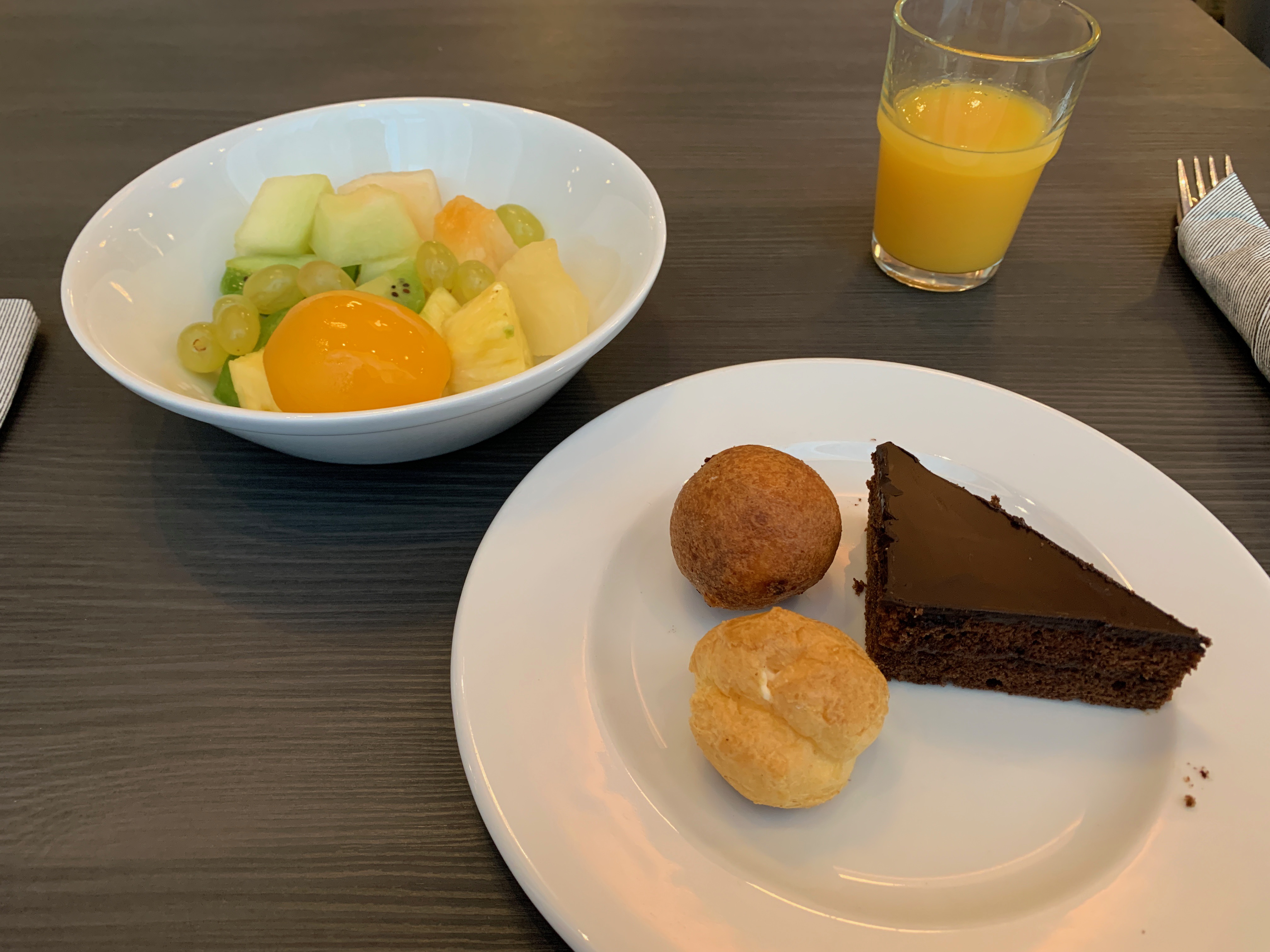
Frühstück im Grand Focus Hotel Szczecin (Ausgewogen sieht anders aus ;-) ) (Eigenes Werk. Lizenz: CC-BY-SA.)
Das Frühstück lässt ebenfalls keine Wünsche offen. Bedingt durch die herrschende Pandemie waren einige Formalitäten (Prüfung des Impfzertifikats) zu klären und dann konnte es los gehen. Die Teller wurden einem nach Wunsch vom Servicepersonal belegt. Von Kuchen über Obstsalat bis hin zum “English breakfast” ist alles dabei.
Für eine oder mehrere Übernachtungen in Stettin ist dieses Hotel sehr zu empfehlen und der schwächelnde Złoty sorgt für günstige Übernachtungen.
